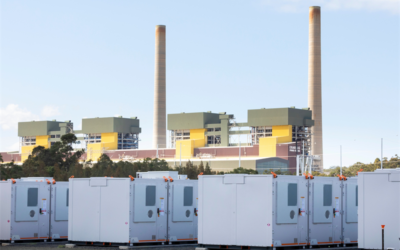
Construction has begun on a 150MW / 150MWh battery storage project at the site of a former fossil fuel plant site in Victoria, Australia.
Project partners Fluence, ENGIE and Macquarie’s Green Investment Group announced today the Hazelwood Battery Energy Storage System (BESS), will benefit from the now-unused 1,600MW of transmission network capacity at the former Hazelwood Power Station site in Victoria’s LaTrobe Valley.
ENGIE and Green Investment Group (GIG) have fully committed to funding the project, which they claimed is the largest privately-funded grid-scale BESS in Australia to date.
“ENGIE’s long-term commitment to Hazelwood and the Latrobe Valley started as a power station operator, then as investor in a multi-million-dollar rehabilitation project and now as the builder and owner of a new energy asset that helps with the decarbonisation of the energy system,” Augustin Honorat, ENGIE’s CEO for Australia and New Zealand said.
Try Premium for just $1
- Full premium access for the first month at only $1
- Converts to an annual rate after 30 days unless cancelled
- Cancel anytime during the trial period
Premium Benefits
- Expert industry analysis and interviews
- Digital access to PV Tech Power journal
- Exclusive event discounts
Or get the full Premium subscription right away
Or continue reading this article for free
“GIG is committed to supporting the green energy transition and storage is critical in enabling ever-expanding renewables capacity and use, to ensure that electricity networks are resilient, reliable and flexible,” GIG’s global head of technology Greg Callman said.
As with projects underway or planned by AGL and others in Australia — and other territories — access to infrastructure at the thermal power plant site offered a great opportunity to locate the new clean energy asset.
As the 1.6GW Hazelwood coal power plant closed in 2017, Australian Energy Market Commission (AEMC) chairman John Pierce said flexible and fast responding generation and services — like battery storage — would have a more and more important role in keeping the electricity system stable through participation in the National Electricity Market (NEM), the wholesale market which covers most of the country.
In fact, generator-retailer AGL is developing another BESS at such a site in the LaTrobe Valley too. AGL has just received planning approval from local government for that one, a 200MW / 800MWh battery system at Loy Yang Power Station.
The Hazelwood BESS is scheduled to be operational by November 2022, in time to aid local electricity networks meet the summer peak demand for electricity.
Again, as with AGL’s Torrens Island battery project which has also just started construction in South Australia, the Hazelwood site offers opportunities for battery capacity expansion over time, should market conditions be favourable.
Technology provider Fluence will provide the full turnkey BESS solution, based on the US company’s GridStack sixth-generation battery storage product. In addition to supplying and constructing it, Fluence will also operate and maintain the BESS over a 20-year contract and the Fluence IQ market optimisation platform will manage its bids in the NEM.
‘Robust project, optimal location’
The announcement comes on the eve of an expected announcement of new electricity market rules by the AEMC, thought to include levies on storage systems that charge with energy from the grid, applicable to batteries as well as pumped hydro.
Objection to these rules from the industry appear to be widespread, due to the potential negative impact on the investability of energy storage in Australia. However, with market opportunities available for frequency response (the FCAS market) and other grid services, the consortium partners on the Hazelwood implied that they are unlikely to be held back by the rules.
The Hazelwood BESS will store excess power generated during times of surplus wind and solar power production and then discharging to help meet peak demand — when the grid is usually more carbon-intensive. It will also participate in the FCAS market.
“The Hazelwood Battery is a robust project in an optimal location, fully committed and with grid connection in place,” the three partners told Energy-Storage.news in response to a question regarding the new rules and their possible impact.
“The project partners will assess the impact of the final [AEMC] determination once it is available…More broadly, we will continue to engage with industry and regulators, to ensure the changes and associated costs associated with the energy transition are minimised for customers.”





